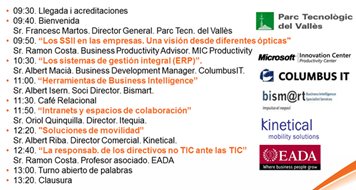Bajo este título y como última jornada de divulgación junto con el Parque Tecnológico del Vallés (www.ptv.es), hemos llevado a cabo un taller para directivos con el objetivo de revisar y presentar diferentes tipos de herramientas tecnológicas de aplicación para las empresas: ERPs, Business Intelligence, Intranets y entornos colaborativos y soluciones de movilidad.
Las diferentes ponencias han sido a cargo de diferentes partners de nuestro centro de innovación, el MIC Productivity: ColumbusIT (www.columbusit.es), BIsmart (www.bismart.es), Itequia (www.itequia.com) y Kinetical (www.kinetical.com)
La introducción y clausura han sido a cargo de un servidor, Ramon Costa, Asesor del MICProductivity (www.micproductivity.com) y profesor asociado del departamento de Operaciones y Sistemas de Información de EADA (www.eada.edu), presentando diferentes maneras de ver las tecnologías de la información (TI) y los sistemas de información (SSII) según:
- su aporte operativo/táctico/estratégico en la empresa
- si son de uso individual / apoyo a la comunicación-colaboración / soporte a proceso empresarial
- o cómo aportan una mejora de la productividad diferenciando el mundo estructurado (procesos – ERP) y el mundo no estructurado (personas – Intranet)
A continuación, cada uno de los ponentes presentó el uso y aplicación de algunas de estas tecnologías:
- Juan Carlos Lozano: ERP
- Albert Isern y Joan Bosch: Business Intelligence
- Albert Riba: Soluciones de Movilidad
- Oriol Fernández: Intranets y entornos colaborativos
Y cómo es habitual en acciones de divulgación del MICProductivity (www.micproductivity), en vez de reproducir algunas de las ideas de los ponentes, preferimos compartir con vosotros, directamente, sus presentaciones.
Finalmente, y como clausura,he compartido con los participantes las diferentes responsabilidades que un directivo no tic debería asumir ante las TIC en sus organización y concluyó con la presentación de 12 aspectos clave para un directivo no tic en temas tic y que podéis consultar en mi blog http://www.pgpsi.com/2010/10/12-it-is-key-concepts-for-non-technical.html










